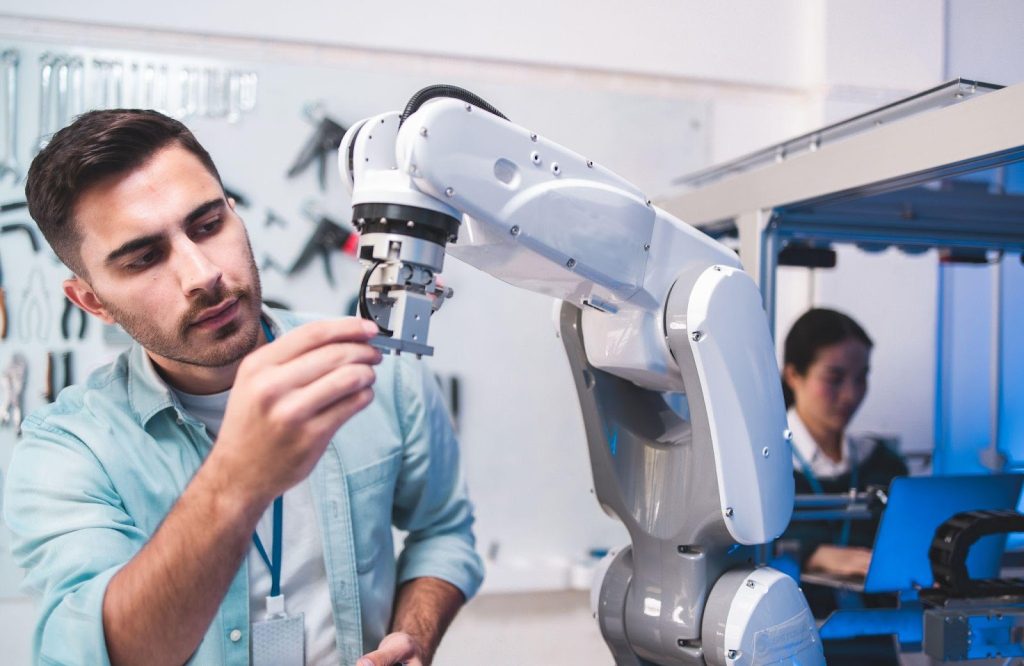Editor’s Note: This is the first of a two-part series on the latest trends and innovations in apprenticeship programs. Part One focuses on US programs. Part Two features some of the most successful apprenticeship programs worldwide.
To anyone paying attention, it’s obvious that the American workforce is in the midst of a significant transformation. And part of that transformation is a comeback of apprenticeships.
Apprenticeships are no longer just about carpenters and electricians. In today’s US economy, they’re expanding into tech firms, hospitals, and even finance companies. A huge plus of these apprenticeship opportunities is that they offer debt-free paths into well-paying careers.

For decades, the default path to success was a four-year college degree. But that mindset is changing due to rising tuition, student loan burdens, and curricula that often don’t align with in-demand real-world skills.
Simple job-market economics are also at work. Employers across different industries are struggling to fill roles that require advanced skillsets, from software and electrical work to healthcare and engineering.
Apprenticeships offer a practical answer: train people on the job while they earn. Done well, these programs align employee learning with what employers actually need. This, in turn, provides a direct route to stable, well-paid careers for more Americans.
So, let’s explore how the apprenticeship model is changing the American labor landscape.
The evolution of apprenticeships in the US
For centuries, apprenticeships were the foundation of American labor—just as they were in many countries around the world.
In the early days of the republic, aspiring craftsmen and tradespeople learned from experienced mentors via long-term apprenticeships. Carpenters, masons, blacksmiths, and printers built their skills during years of supervised work. This meant that essential trades continued from one generation to the next, while also providing up-and-coming workers with stable employment.
As industrialization took hold, apprenticeships remained a key pathway into manufacturing and construction jobs. However, in the mid-20th century, new trends emerged that impacted apprenticeship programs. These included:
- Apprenticeships in manufacturing and construction: These fields continued to rely on apprenticeships, particularly through union-led programs in sectors like plumbing, electrical work, and carpentry. The GI Bill (1944) and other postwar policies helped expand some apprenticeship programs. However, these did not grow at the same rate as college enrollments.
- The rise of college education: After World War II, higher education became increasingly prioritized. The GI Bill dramatically increased college attendance, and by the 1960s and 1970s, the idea that a four-year degree was the best pathway to success became the dominant mental model. This did not necessarily cause a steep decline in traditional apprenticeships, but did shift public perception and workforce priorities.
- Impact of white-collar job growth: As service-sector and white-collar jobs expanded, especially with technological advancements, there was a growing preference for college degrees over vocational training. However, traditional trade apprenticeships largely held steady, particularly within unions.
- Late 20th-century trends: By the 1980s and 1990s, deregulation, offshoring, and automation reduced the demand for some traditional trade jobs. These factors contributed to stagnation in apprenticeship numbers. Meanwhile, college attendance rates continued to rise.
By the 21st century, cracks in the college-first assumption became clear. A growing skills gap, soaring tuition costs, and an oversupply of degree-holders without hands-on experience forced industries to rethink how they train their workforce.
A renaissance in US apprenticeship programs
Recognizing these challenges, industry leaders and policymakers in the US began efforts to reinvigorate apprenticeships.
In the early 2000s, federal and state programs started expanding funding and incentives for vocational training. Employers in sectors beyond the traditional trades, such as information technology, healthcare, and advanced manufacturing, began exploring new apprenticeship models and upgrading existing models to cultivate more skilled workers.
In the same vein, improved collaborations between community colleges, technical schools, and industry groups sought to bridge the disconnect between academic higher education and employment. These partnerships offered more direct pathways to stable careers that did not require a four-year college degree.
Catching up to Europe
Unlike in the US, many European countries maintained strong vocational education systems throughout the 20th and 21st centuries. While the American model placed heavy emphasis on a college-first approach, European nations continued to offer well-defined vocational tracks from an early age and integrated apprenticeships into their education systems.
In countries like Germany, the Netherlands, and Switzerland, for example, students are guided toward academic or vocational pathways by the time they reach middle school. Trade-based careers remained a respected and viable option.
So, compared to Europe, the US has had to play catch-up in recognizing and reinstating apprenticeships as a legitimate alternative to higher education. But the promising results of this changing approach are now becoming visible.

What do US apprenticeships look like today?
In the US, today’s apprenticeships look quite different from those of the past. This evolution reflects how various industries are adjusting their programs to the needs of the labor market. For example:
- In information technology, cybersecurity apprenticeships train workers in real-world digital security challenges while they earn credentials. For example, the Cybersecurity Apprenticeship Program, hosted by the US Department of Homeland Security (DHS), offers students opportunities to work alongside cyber professionals in DHS departments to tackle real-world digital security challenges.
- An example of a private-sector apprenticeship program in healthcare is the Medical Assistant Apprenticeship Program offered by CHAS Health. This apprenticeship includes 2,000 hours of on-the-job training and covers the program cost for individuals looking to become Certified Medical Assistants. The training spans one year, after which participants are required to pass the CCMA exam. The program is a registered apprenticeship affiliated with the Washington State Department of Labor and Industries.
- In advanced manufacturing, apprentices are taught to operate and maintain high-tech machinery in a rapidly evolving field. For example, the Aerospace Joint Apprenticeship Committee offers apprenticeships in roles such as machinist, tool and die maker, and industrial maintenance technician. These specialized positions provide hands-on training in industry-leading aerospace manufacturing technologies.

At the heart of this shift is a growing recognition that learning through experience often yields a deeper understanding and stronger retention of practical job skills than classroom instruction alone, especially when it’s paired with well-timed and appropriately-dosed formal training.
For instance, hybrid apprenticeships now allow people to earn college credits while they work. These models provide the best of both worlds: graduates have practical experience that makes them job-ready, while they are also equipped with academic credentials that open doors to career growth.
A new apprenticeship mindset
The revival of apprenticeships reflects a changing mindset—one that values skill development, financial stability, and real-world learning as much as, if not more than, traditional higher education.
Here are three examples of major companies that are integrating apprenticeships into their hiring strategies:
- Aon’s apprenticeship program: This professional services company offers a two-year, full-time apprenticeship program. Participants can earn an associate’s degree while they gain hands-on experience in areas such as business support, data, project management, and information technology. Apprentices receive a salary, benefits, and full tuition coverage.
- Zurich Insurance’s apprenticeship program: The Fortune 500 company’s two-year apprenticeship makes it possible for participants to earn a degree while launching a career in insurance. The program blends paid, on-the-job learning with college coursework. It covers tuition for apprentices who are pursuing either an associate’s or a bachelor’s degree. Focus areas include underwriting, claims, and other insurance specialties.
- Dow’s US apprenticeship program: The materials science industry leader offers its apprentices the opportunity to earn competitive wages and full college tuition while receiving specialized training in manufacturing roles such as process technician, instrument technician, and electrical technician.
Hybrid models like these, that blend college education with on-the-job training, continue to gain traction in the US.
How modern apprenticeship programs work
Apprenticeships aren’t just jobs with training attached. With few exceptions, they are structured career pathways designed to develop skilled professionals from the ground up. Most apprenticeships follow a framework that helps apprentices learn skills that build on each other. They gradually master more advanced skills and earn industry-recognized credentials.
At the core of these programs is paid on-the-job training. Apprentices start as entry-level workers but receive hands-on guidance from experienced mentors. As they develop their skills, they receive incremental wage increases in line with their growing expertise.
This “earn while you learn” model makes apprenticeships one of the few workforce training programs that help participants build financial stability from day one.



